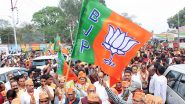New Delhi, May 16 (PTI) The Reserve Bank's decision to raise benchmark interest rates and the likelihood of a good monsoon will help in containing inflation, Sanjiv Bajaj, the newly-elected president of industry body CII, said on Monday.
"I do believe that we are now in an era of higher interest rates. This will help us in bringing down inflation, at least a part of that going forward," Bajaj said, addressing his maiden press conference after taking over as the CII chief.
He said various factors combined with the hope of a strong monsoon "should put us in a better place" by the second half of the year for policymakers to decide where inflation and interest rates move.
Bajaj observed that the rise of inflation has two aspects -- demand and supply side.
Also Read | Monsoon 2022 Forecast: Southwest Monsoon Advances Over Andaman and Nicobar Islands, Says IMD.
"RBI has already started the cycle of taking interest rates up and we should expect interest rates to continue moving up in the coming year. We would expect from RBI a clear direction to how they are going to address interest rates. Hopefully in the next monetary policy review we should be able to hear from them something to that extent," he said.
CII estimates India's GDP growth to be in the band of 7.4 - 8.2 per cent, depending upon the global oil prices.
The industry body's theme for 2022-23 is Beyond India@75: Competitiveness, Growth, Sustainability, and Internationalisation.
Sharing the likely growth scenarios for the Indian economy for this year, Bajaj, said, "CII expects the GDP growth in a range of 7.4-8.2 per cent in 2022-23, with the outlook critically hinging on the trajectory of global crude oil prices."
He was addressing the media for the first time after taking over as president CII. He further explained, "global headwinds and inflation will have to be countered with robust policy reforms, both domestic and external sector reforms, to unlock the growth potential of the economy."
Bajaj said tailwinds that are supportive of growth in the short-term include government capex, private sector investment which is showing an uptick aided by strong demand in some sectors and the PLI (Production-Linked Incentive) scheme push in the others, good agriculture season on the back of the expectations of a good monsoon and positive export momentum.
An immediate measure to moderate inflation could be to moderate taxes on fuel products, which constitute a large share of the retail pump prices of petrol and diesel. "CII would encourage Centre and state governments to collaborate in reducing these duties," he added.
Sharing the vision for the economy, Bajaj said that India has the potential to become a USD 40 trillion economy by the time it turns 100, in 2047, with milestones at USD 5 trillion by 2026-27 and USD 9 trillion by 2030-31.
Highlighting the sectoral drivers of growth, he elaborated that manufacturing and services will be the twin engines of growth. The enabling policies of the government, particularly the PLI scheme, are expected to push manufacturing sector's contribution in gross value addition to 27 per cent by FY48.
Similarly, services, too, will witness its share rising from 53 per cent to 55 per cent in the terminal year. The contribution of exports to GDP must rise while the investment rate must be stepped up. Both the government and industry must be equal partners in achieving this, the CII president said.
(This is an unedited and auto-generated story from Syndicated News feed, LatestLY Staff may not have modified or edited the content body)














 Quickly
Quickly















